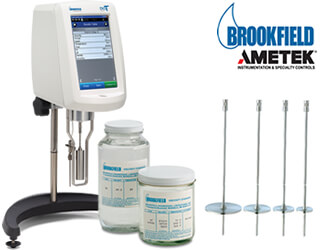How to Achieve Successful Viscosity Measurements in 3 Steps!
Viscosity behaviour allows manufacturers to understand and gather key information about their products, by quantifying their flow behaviour properties. This is quite important for production, as it is based on the viscosity readings, that the R&D lab can make different decisions regarding how to mix a certain product during the manufacturing process, how to store it, ship it and even how consumers are going to use it.
How it works?
The viscometer or rheometer measures the viscosity of your sample using a spindle – samples can be of any kind, pharmaceutical liquids or semi-solid materials like creams/ointments – and then, the viscosity flow curves shown in the instrument, will characterize a typical flow behaviour of that sample. The faster the spindle rotates, the lower the viscosity.
At that stage, R&D will select a data point on the viscosity flow curve and direct QC to test for that value when testing the production batches for shipment.
How Do I Get Viscosity Right?
There are three things you need to consider in order to achieve successful viscosity measurements and keep your production up and running:

- The viscosity range of the product
- The right viscometer/rheometer
- Limit of viscosity measurement
Different products have different viscosity ranges, which impacts greatly on how they are analysed. Therefore, knowing the viscosity range of the products to be tested is step one. That will determine your choice of rheometer/viscometer, as the instrument must have the appropriate torque measurement range.
Scientific units of centipoise (cP) are typically used in North America, while other parts of the world use milli-Pascal seconds (mPa*s) as well:
1cP = 1mPa*s. Water is the reference material with viscosity of 1cP at 20º Celsius. Typically, medicinal liquids that are to be swallowed, like cough syrup, are below 100cP. Rubbing ointments may be around 1,000cP or higher. Thick creams can start around 10,000cP.
If you would like to know more about getting your viscosity measurements right, please contact our Sales Team.
How do I Select My Viscometer?
You start with your torque range. There are two basic torque ranges used for most pharmaceutical products: “LV” & “RV”. The first applies to low viscosity materials, while “RV” is used for more “medium” or “regular” viscosity products. There are also “HA” or “HB” viscometers, that are used if you require higher viscosity measurements. However, these are not usually used to test pharmaceutical liquids and/or creams/ointments.
Once the toque range is decided you need to consider other factors like, which spindle and speed is more appropriate for your type of sample; or is the sample temperature or time sensitive? All these requirements must be matched by the operating features of the instrument.
Regarding the spindle, there are many types to choose from. They are usually cylindrical in shape, or may have a disc at the bottom – these are the most common type found in QC labs.
If the sample is time and/or temperature sensitive, then the chosen instrument should come with built-in options like a clock to time how long the spindle needs to rotate before the viscosity data point is captured; and also a built-in temperature probe to verify the temperture of the sample.
If you would like to know more about how to choose the right viscometer for your application, please contact our Sales Team.
How Do I Know if Viscosity Results are Correct?
The third and final step before your product can be approved for shipment is for your QC to know the acceptable limits for the viscosity measurement.
R&D will do testing on multiple samples during the validation process to establish minimum and maximum cP values for the QC test. If the sample has a viscosity measurement that falls between these values, the product passes the test. However, if the viscosity measurement falls outside of the said values, the first thing to do would be to verify if the instrument is reading correctly. This can be done with a simple calibration test using viscosity standards, which are certified to have specific viscosity values.
If the QC instrument can measure the stated value of the standard (or is sufficiently close to it), that means it is reading viscosity correctly. At this point all that is left to do is for QC to report that the product failed the viscosity test and go back to R&D to verify the test method or technique for making a valid viscosity test.
If you are struggling with your viscosity results, please contact our Sales Team.
Where Can I Find Out More About Viscosity?
Our full Brookfield Ametek Viscometer range is available on our website. If you have a need that is not covered in this range, please contact our Sales Team. You can also find more information on our Viscosity FAQ page.
Discover our Viscosity Range |
Discover Viscosity, Texture & Powder with Lab Unlimited!
Discover more about viscosity, texture, and powder analysis with Lab Unlimited.
Contact our team for technical support, guidance, or to explore our full range of Brookfield AMETEK instruments and viscosity standards.
